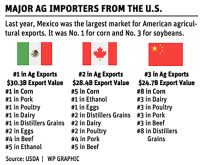SAN ANTONIO, Texas — Day one of the 2017 Commodity Classic ended with a series of press conferences for the 165 journalists attending the event.
The most intriguing one was the joint Bayer-Monsanto press conference where two former adversaries embraced one another for a photo opp.
Adrian Percy, global head of research and development with Bayer, and Robert Fraley, chief technology officer with Monsanto, talked to reporters about the benefits of merging the two companies.
They said wheat is one of the crops that will benefit the most from the merger because each company is not spending enough on the crop individually to make a difference but together they will have the critical mass to give wheat the attention it needs.
Percy said Bayer’s takeover of Monsanto is on track and is expected to be completed by the end of 2017.
Video: Darcy Pawlik, North American cereals portfolio lead for Syngenta, provides an update on the company’s hybrid wheat program
FARM BILL
Leaders of U.S. soy, corn and wheat groups spoke to media about their policy priorities for 2017.
At the top of everybody’s list is the 2018 Farm Bill that among other things sets out what the farm safety net will be over the next four years.
Net U.S. farm income in 2017 is expected to be down 50 percent from 2013 levels, so farmers are keen on having a robust safety net program.
Read Also

Manitoba community projects get support from HyLife
HyLife Fun Days 2025 donated $35,000 each to recreation and housing projects in Killarney, Steinach and Neepawa earlier this fall.
“Now is not the time to cut support for farm programs,” said Ron Moore, president of the American Soybean Association.
He vowed farm groups will be on the same page this time around.
“In the previous Farm Bill it took longer than expected because we weren’t speaking in a unified manner,” he said.
The fractured voice in the farm community delayed implementation of the 2014 Farm Bill by a year.
Farm groups already seem unified in what they want to see in the 2018 bill and maintaining crop insurance is one of the top priorities.
“We will vigorously defend the federal crop insurance program,” said Moore.
They also want to see a doubling in the budgets of the Market Access Program and Farmers Market Promotion Program to US$469 million.
Mike Conaway, chair of the U.S. House of Representatives Committee on Agriculture, said the 2018 bill will not be delayed.
“I am committed, driven quite frankly, to get the Farm Bill done on time,” he said.
Conaway said a farm safety net will be easier to sell to the U.S. Congress in an era of sub-$4 per bushel corn than it was during the 2014 Farm Bill negotiations when corn was $7.
The other thing the farm sector has going for it is that spending on the 2014 bill was supposed to be $23 billion less than the previous bill but the saving ended up being far greater.
“We’re spending $100 billion less on the Farm Bill,” he said.
Conway is pushing for the same overall budget as 2014. He warned farmers that if they want an increase in spending in one area it will have to come out of another.
TRADE
Another big theme raised by farm groups in their press conferences was their unease with U.S. President Donald Trump’s protectionist stance on trade and his provocation of Mexico and China.
All of the groups said they were disappointed with Trump’s decision to pull out of the Trans Pacific Partnership (TPP).
Brett Blankenship, past-president of the National Association of Wheat Growers, said the World Trade Organization recognizes 250 bilateral trade deals around the globe. The U.S. is party to only 17 of those.
“We had an opportunity to catch up in a great way with the TPP,” he said.
The groups want Trump’s administration to expedite a series of bilateral deals with the TPP countries. They also expressed trepidation about re-opening NAFTA, which has paid dividends with Mexico recently becoming the top market for U.S. corn.
HYBRID WHEAT
Darcy Pawlik, North American cereals portfolio lead for Syngenta, provided on update on the company’s hybrid wheat program.
He said the company is on track to launch its first hybrid wheat varieties in the U.S. by the end of this decade. Commercialization of the product in Canada will be later due to the variety registration process.
Pawlik said the first generation of hybrids are meeting expectations, including delivering a 10 percent yield boost over existing wheat varieties.
sean.pratt@producer.com
















